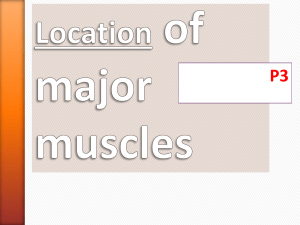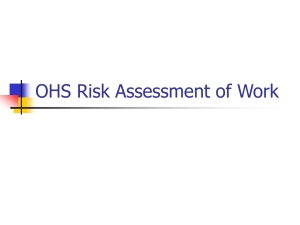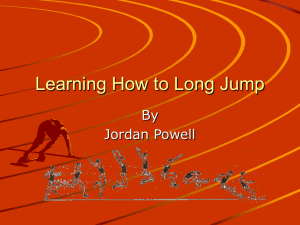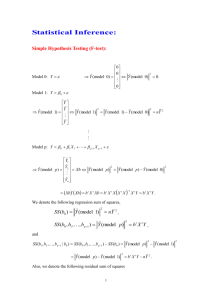How to Perform a Chi Square Test of Independence in SPSS
advertisement
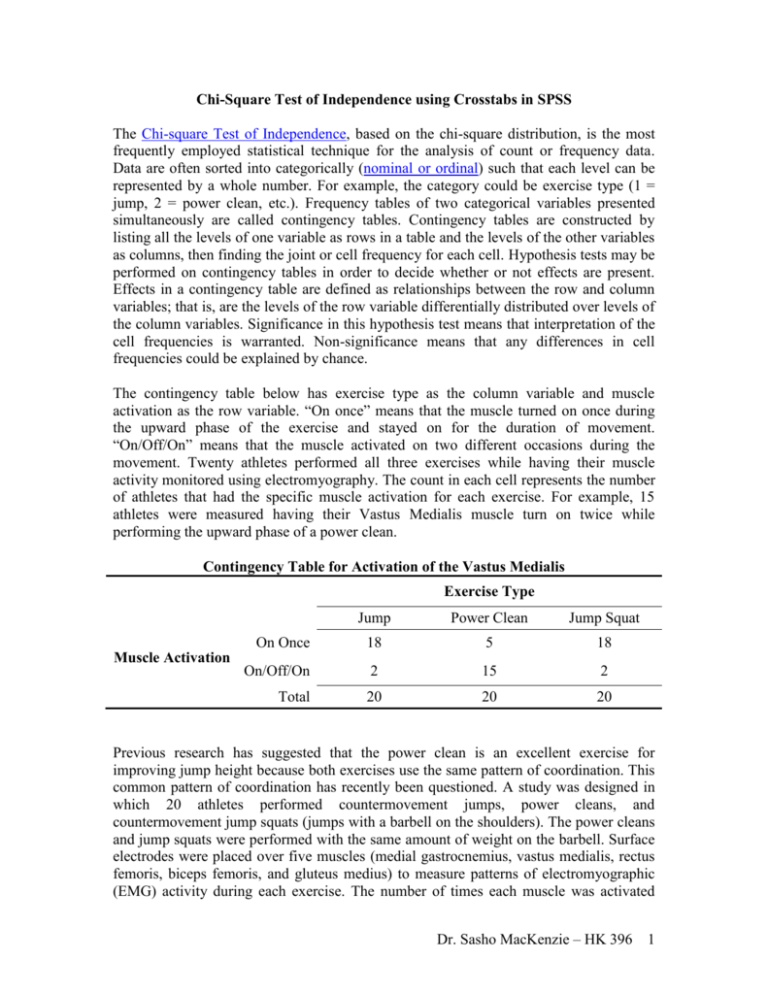
Chi-Square Test of Independence using Crosstabs in SPSS The Chi-square Test of Independence, based on the chi-square distribution, is the most frequently employed statistical technique for the analysis of count or frequency data. Data are often sorted into categorically (nominal or ordinal) such that each level can be represented by a whole number. For example, the category could be exercise type (1 = jump, 2 = power clean, etc.). Frequency tables of two categorical variables presented simultaneously are called contingency tables. Contingency tables are constructed by listing all the levels of one variable as rows in a table and the levels of the other variables as columns, then finding the joint or cell frequency for each cell. Hypothesis tests may be performed on contingency tables in order to decide whether or not effects are present. Effects in a contingency table are defined as relationships between the row and column variables; that is, are the levels of the row variable differentially distributed over levels of the column variables. Significance in this hypothesis test means that interpretation of the cell frequencies is warranted. Non-significance means that any differences in cell frequencies could be explained by chance. The contingency table below has exercise type as the column variable and muscle activation as the row variable. “On once” means that the muscle turned on once during the upward phase of the exercise and stayed on for the duration of movement. “On/Off/On” means that the muscle activated on two different occasions during the movement. Twenty athletes performed all three exercises while having their muscle activity monitored using electromyography. The count in each cell represents the number of athletes that had the specific muscle activation for each exercise. For example, 15 athletes were measured having their Vastus Medialis muscle turn on twice while performing the upward phase of a power clean. Contingency Table for Activation of the Vastus Medialis Exercise Type Muscle Activation Jump Power Clean Jump Squat On Once 18 5 18 On/Off/On 2 15 2 Total 20 20 20 Previous research has suggested that the power clean is an excellent exercise for improving jump height because both exercises use the same pattern of coordination. This common pattern of coordination has recently been questioned. A study was designed in which 20 athletes performed countermovement jumps, power cleans, and countermovement jump squats (jumps with a barbell on the shoulders). The power cleans and jump squats were performed with the same amount of weight on the barbell. Surface electrodes were placed over five muscles (medial gastrocnemius, vastus medialis, rectus femoris, biceps femoris, and gluteus medius) to measure patterns of electromyographic (EMG) activity during each exercise. The number of times each muscle was activated Dr. Sasho MacKenzie – HK 396 1 was determined from the EMG signal. The researcher hypothesized that the knee flexors (vastus medialis and rectus femoris) would show different patterns of activation due to the power clean’s characteristic 2nd knee flexion during the upward phase. The knees flex once during the downward phase of the power clean, and then again about 2/3 into the upward movement. This is not seen during a jump. The crosstabulation table is the basic technique for examining the relationship between two categorical variables (muscle activation pattern and exercise), possibly controlling for additional layering variables (individual muscles). The Crosstabs procedure in SPSS offers tests of independence. Use the Crosstabs procedure to test the hypothesis that the patterns of muscle activation are consistent across the different exercises depending on the muscle investigated. Open SPSS from the Webfx folder on the desktop, and then open the file Chi Square EMG Sasho.sav. The data must be set-up in a particular manner in order to use Crosstabs and to perform a Chi Square Test of Independence (Figure 1). The Subject column identifies the subject (1 to 20). The Exercise column identifies the type of exercise (1 = Jump, 2 = Power Clean, 3 = Jump Squat). The Muscle column identifies the specific muscle (1 = gastroc, 2 = vastus med, 3 = rectus, 4 = biceps fem., 5 = gluteus). The Activation column represents the number of times the muscle turned on. For example, the first row indicates that Subject 1, while performing exercise 1 (Jump), had muscle 1(gastroc) turn on 2 times. There are, 20 subjects x 3 exercises x 5 muscles = 300 different activation counts, so there are 300 rows in the file. Figure 1 Dr. Sasho MacKenzie – HK 396 2 To perform the Chi Square Test of Independence, you need to click on the Analyze -> Descriptive Statistics -> Crosstabs, as in Figure 2. Figure 2 After this, the Crosstabs dialog box will appear (Figure 3). In this box, you'll be able to select the categorical variables to be cross-tabulated. Activation is the row variable and Exercise is the column variable, while Muscle is the “Layer” variable. By selecting a layer variable, SPSS will perform a separate Chi Square test for each of the 5 muscles. This is important since only some muscles may demonstrate different patterns of activation depending on the exercise, while other muscles may have the same pattern of activation for each exercise. Check, Display clustered bar charts, and then click Statistics. In the Crosstabs: Statistics box (Figure 4), check Chi-square and Phi and Cramer’s V, then hit Continue. From the original Crosstabs box, select Cells. In the Crosstabs: Cell Display box, make the selection shown in Figure 5 below and hit continue. From the original Crosstabs box, select Exact. In the Exact Tests box (Figure 6), select Exact, and then hit Continue. From the Crosstabs box hit OK to run the analysis. Dr. Sasho MacKenzie – HK 396 3 Figure 3 Figure 4 Dr. Sasho MacKenzie – HK 396 4 Figure 5 Figure 6 The observed and expected frequencies are shown for three muscles in the SPSS output in Figure 7 below. By comparing the cells highlighted in turquoise for the knee flexor muscles, you can see that the Clean has a much higher count for the On/Off/On scenario. For the Vastus Medialis, 15 of the subjects had a double activation for the Clean, while only 2 should a double activation for the Jump and Jump Squat. While this “looks” different, this qualitative assessment needs to be confirmed with a statistical test. Dr. Sasho MacKenzie – HK 396 5 Number of Activa tions * Type of Exerice * Muscle Crosstabulation Ty pe of Ex erice Jump Clean Jump Squat Total Number of On onc e Count 16 16 17 49 Ac tivat ions Ex pec ted Count 16.3 16.3 16.3 49.0 Residual -.3 -.3 .7 St d. Residual -.1 -.1 .2 Adjust ed Residual -.2 -.2 .5 On/Off/On Count 4 4 3 11 Ex pec ted Count 3.7 3.7 3.7 11.0 Residual .3 .3 -.7 St d. Residual .2 .2 -.3 Adjust ed Residual .2 .2 -.5 Total Count 20 20 20 60 Ex pec ted Count 20.0 20.0 20.0 60.0 Vastus Medialus Number of On onc e Count 18 5 18 41 Ac tivat ions Ex pec ted Count 13.7 13.7 13.7 41.0 Residual 4.3 -8. 7 4.3 St d. Residual 1.2 -2. 3 1.2 Adjust ed Residual 2.6 -5. 1 2.6 On/Off/On Count 2 15 2 19 Ex pec ted Count 6.3 6.3 6.3 19.0 Residual -4. 3 8.7 -4. 3 St d. Residual -1. 7 3.4 -1. 7 Adjust ed Residual -2. 6 5.1 -2. 6 Total Count 20 20 20 60 Ex pec ted Count 20.0 20.0 20.0 60.0 Rectus Femoris Number of On onc e Count 15 5 17 37 Ac tivat ions Ex pec ted Count 12.3 12.3 12.3 37.0 Residual 2.7 -7. 3 4.7 St d. Residual .8 -2. 1 1.3 Adjust ed Residual 1.5 -4. 1 2.6 On/Off/On Count 5 15 3 23 Ex pec ted Count 7.7 7.7 7.7 23.0 Residual -2. 7 7.3 -4. 7 St d. Residual -1. 0 2.6 -1. 7 Adjust ed Residual -1. 5 4.1 -2. 6 Total Count 20 20 20 60 Ex pec ted Count 20.0 20.0 20.0 60.0 Bic eps Femoris Number of On onc e Count 12 17 15 44 Figure 7 Ac tivat ions Ex pec ted Count 14.7 14.7 14.7 44.0 Residual -2. 7 2.3 .3 St d. Residual -.7 .6 .1 Adjust ed Residual The table below (Figure 8) shows the results of the Chi-square test As -1. 7 1.4 of Independence. .2 On/Off/On Count 8 can see 3 that both5 the Vastus 16 usual a p-value < .05 indicates statistical significance. We pec ted Count 5.3 5.3 Medialis and Rectus Femoris haveExsignificant Chi-square values, which 5.3 confirms16.0 our Residual 2.7 -2. 3 -.3 visual inspection of the cell counts in the figure above. Note the -1. highlighted points a) and St d. Residual 1.2 0 -.1 i) below the table, you will see thatAdjust we’ve violated an assumption of the Chi-square test. ed Residual 1.7 -1. 4 -.2 Total an expected cell Countcount less than 5. 20 When this 20 20 we should 60 No cell should have happens pec ted Count 20.0 However, 60.0 report the Fisher Exact Test and notExthe Chi-square test20.0 (Warner,20.0 2008, p.334). Medius onc e Count 19 18 17 theGluteus expected cellNumber countsof forOnthe Vastus Medialis and Rectus Femoris are greater than 5,54so Ac tivat ions Ex pec ted Count 18.0 18.0 18.0 54.0 we can report on the Chi-square statistic for these muscles. Residual 1.0 .0 -1. 0 St d. Residual .2 .0 -.2 Adjust ed Residual .9 .0 -.9 On/Off/On Count 1 2 3 6 Ex pec ted Count 2.0 2.0 2.0 6.0 Residual -1. 0Sasho MacKenzie .0 1.0 Dr. – HK 396 6 St d. Residual -.7 .0 .7 Adjust ed Residual -.9 .0 .9 Total Count 20 20 20 60 Muscle Gastrocnemius Chi-Square Tests Muscle Gastrocnemius Vastus Medialus Rectus Femoris Biceps Femoris Gluteus Medius Pearson Chi-Square Likelihood Ratio Fis her's Exact Test Linear-by-Linear As sociation N of Valid Cases Pearson Chi-Square Likelihood Ratio Fis her's Exact Test Linear-by-Linear As sociation N of Valid Cases Pearson Chi-Square Likelihood Ratio Fis her's Exact Test Linear-by-Linear As sociation N of Valid Cases Pearson Chi-Square Likelihood Ratio Fis her's Exact Test Linear-by-Linear As sociation N of Valid Cases Pearson Chi-Square Likelihood Ratio Fis her's Exact Test Linear-by-Linear As sociation N of Valid Cases Exact Sig. (2-sided) 1.000 1.000 1.000 Exact Sig. (1-sided) Point Probability 2 2 As ymp. Sig. (2-sided) .895 .892 1 .685 .841 .420 .147 2 2 .000 .000 .000002 .000 .000002 1 1.000 1.000 .567 .133 2 2 .000 .000 .000154 .000 .000221 .416 1 .519 .629 .315 .104 60 3.239g 3.268 3.110 2 2 .198 .195 .237 .237 .237 1.131 1 .287 .376 .188 .081 60 1.111i 1.158 1.142 2 2 .574 .561 .863 .863 .863 1 .296 .439 .220 .123 Value .223a .229 .329 b .164 60 26.033 c 26.420 24.715 d .000 60 17.485 e 17.986 17.025 f h j 1.093 df 60 a. 3 cells (50.0%) have expected count less than 5. The minimum expected count is 3.67. b. The standardized statistic is -.405. c. 0 cells (.0%) have expected count less than 5. The minimum expected count is 6.33. d. The standardized statistic is .000. e. 0 cells (.0%) have expected count less than 5. The minimum expected count is 7.67. f. The standardized statistic is -.645. g. 0 cells (.0%) have expected count less than 5. The minimum expected count is 5.33. h. The standardized statistic is -1.064. i. 3 cells (50.0%) have expected count less than 5. The minimum expected count is 2.00. j. The standardized statistic is 1.045. Figure 8 The significant Chi-square results indicate that there is a reliable relationship between the variables, but it doesn’t indicate the strength of the relationship, which is referred to as the effect size. Phi is the most common effect size statistic reported when interpreting the results of a Chi-square analysis and has the same range as Cohen’s d. The table below (Figure 9) indicates that the relationship is strong for both the Vastus Medialis and Rectus Femoris. Dr. Sasho MacKenzie – HK 396 7 Symm etri c Me asures Muscle Gastrocnemius Nominal by Nominal Phi Cramer's V Vastus Medialus N of V alid Cases Nominal by Nominal Phi Cramer's V Rectus Femoris N of V alid Cases Nominal by Nominal Phi Cramer's V Biceps Femoris N of V alid Cases Nominal by Nominal Phi Cramer's V Gluteus Medius N of V alid Cases Nominal by Nominal Phi Cramer's V N of V alid Cases Value .061 .061 60 .659 .659 60 .540 .540 60 .232 .232 60 .136 .136 60 Approx . Sig. Ex act Sig. .895 1.000 .895 1.000 .000 .000 .000 .000 .000 .000 .000 .000 .198 .198 .237 .237 .574 .574 .863 .863 a. Not as suming the null hypothes is. b. Us ing the asymptotic s tandard error ass uming the null hypot hesis. Figure 9 Now that we know there is a significant, and meaningful, relationship, we have to perform a post hoc analysis to determine where the differences exist. This is similar to a Tukey or Scheffe test following the initial F-test with an ANOVA. We will compare the standardized residuals as suggested by Beasley and Schumaker (1995). This was found to maintain Type I error at a satisfactory level by MacDonald and Gardner (2000). The standardized residuals are found in Figure 7 above. Those standardized residuals which are greater than 1.96 (or less than -1.96) indicate those exercises that contributed to the significant Chi-square finding. Not surprisingly, we can see that the standardized residuals for the Clean are greater than 1.96. Therefore we can conclude that the pattern of muscle activation during the Clean was different from both the Jump and Jump Squat, but that the pattern between the Jump and Jump Squat was not different. These results would be written up as follows for the Vastus Medialis: Of the 20 participants, 15 demonstrated a double activation pattern of the Vastus Medialis during the upward phase of the power clean, while only 2 participants showed a double activation pattern for both the jump and jump squat. This was a statistically significant association: 2 (2) = 26.03, p < .001, with a strong effect size ( = .659). Post-hoc tests, using standardized residuals, indicated that the pattern of muscle activation during the Clean was different from both the Jump and Jump Squat, but that the pattern between the Jump and Jump Squat was not different. Dr. Sasho MacKenzie – HK 396 8

